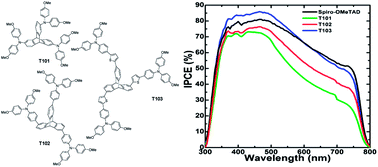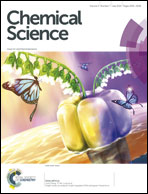Novel hole transporting materials based on triptycene core for high efficiency mesoscopic perovskite solar cells†
Abstract
Three novel hole-conducting molecules (T101, T102 and T103) based on a triptycene core have been synthesized using short routes with high yields. The optical and electrochemical properties were tuned by modifying the functional groups, through linking the triptycene to diphenylamines via phenyl and/or thienyl groups. The mesoporous perovskite solar cells fabricated using T102 and T103 as the hole transporting material (HTM) showed a power conversion efficiency (PCE) of 12.24% and 12.38%, respectively, which is comparable to that obtained using the best performing HTM spiro-OMeTAD. The T102 based device showed higher fill factor (69.1%) and Voc (1.03 V) than the spiro-OMeTAD based device (FF = 63.4%, Voc = 0.976 V) whereas the T103 based device showed comparable Jsc (20.3 mA cm−2) and higher Voc (0.985 V) than the spiro-OMeTAD (Jsc = 20.8 mA cm−2) based cell.


 Please wait while we load your content...
Please wait while we load your content...